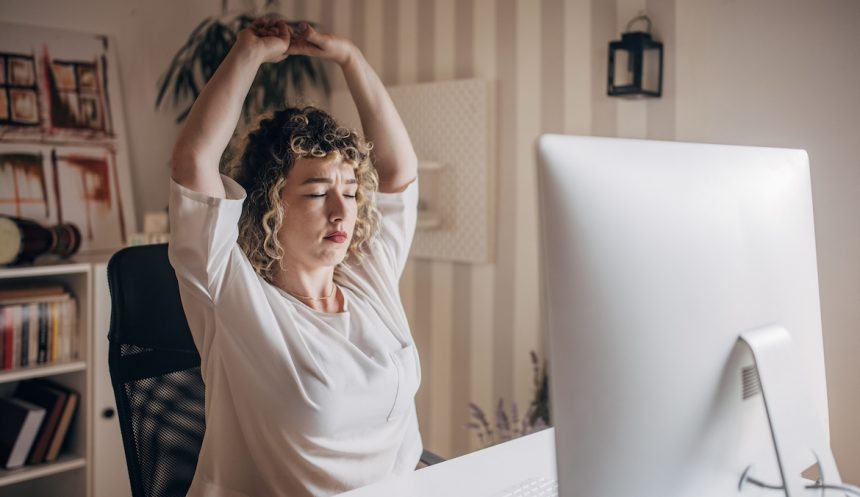If you, too, live the constantly-hunched-over-a-digital-device life, you may notice a bump start to develop at the base of your neck, and wonder how to fix that dang neck hump. The most common cause of the neck hump is—you guessed it—poor posture.
“Not sitting correctly in front of your laptop or computer, or sitting hunched with your neck leaning forward when you’re on your phone can cause the muscles in your neck to work differently and your shoulders to get hunched forward, developing a curved hump,” says licensed chiropractor Suzanna Wong, DC. “The muscle at the back of the neck gets too long, and the muscle at the front of the neck becomes too short, which causes the hump.”
What actually is the neck hump? Bone? Muscle? Other tissue? The hump shape comes from a curvature in your spine. That’s why your head juts forward, too, because your spine is curving rather than holding your head upright. With that shape and added load of the head, the muscles around your neck and upper back also have to work overtime to make up for your curved-forward neck.
“Every inch our heads shift forwards adds an extra 10 pounds of pressure on the neck and upper back muscles,” says Michelle Falzone, CEP, exercise physiologist and owner of Pivot Your Wellness. So an overdeveloped trapezius (a muscle that runs from the base of your neck to the middle of your back) and levator scapulae (a muscle that runs from below your ear to the top of your shoulder) might also contribute to the look and shape of the hump.
There is also a fat pad at the base of your neck between your shoulder blades. Some people carry more fat in some places than other people. You could be genetically predisposed to have more fat in this location.
What causes a neck hump? Improper posture is the main culprit of the neck hump. However, Falzone prefers to refer to this as “low postural awareness.” Postural awareness is “your mindfulness of the position in which you hold your body during different activities,” she says. Having low postural awareness can mean that you’re not conscious that you’re staying in a shoulder-rounded, head-jutted position for extended periods of time, which can cause the neck hump.
However, “staying in any static—aka non-moving— posture, whether sitting with a rounded back or standing as straight as a soldier for hours on end, both can be detrimental for the body.” There can be other causes of the feature, too: Osteoporosis, degenerative changes in your spine through low postural awareness, arthritis, tumors and infections, fractures, calcifications of ligaments in the spine, congenital factors, and Scheuermann’s kyphosis—when your spine develops into a wedge shape instead of a rectangle, most common for teenagers—can all be behind a neck hump, Falzone says.
What are other names for the neck hump? The “neck hump” is also known as text neck, the groan-worthy “dowager’s hump” (from a prevalence of the feature in older women thanks to osteoporosis), text hump, and round back. Its official medical name is kyphosis, according to the Mayo Clinic.
Is a buffalo hump the same as a neck hump or dowager hump? No. A buffalo hump refers to an enlarged fat pad in this area. While some people might genetically store more fat here, this can also be a symptom of Cushing Syndrome.
Is a neck hump harmful? While the hump itself is not harmful, poor posture, which leads to the neck hump, can cause pain and have effects throughout the body. “Everyday living can become a challenge, from getting out of a chair to having the upper-body mobility to reach overhead for objects,” Falzone says. “Since our spine changes its position, therefore its mechanics, it can put strain on our neck and back, and bring on chronic pain not only in these areas, but also in our lower body. Alongside joint pain, it can encourage the development of headaches, poor sleep, and disrupted digestion.” Falzone also notes there can be mental ramifications. “An upright posture has been shown1 to promote higher self-esteem, more arousal, better mood, and lower fear, compared to slumped postures,” Falzone says.
Can you “fix” a neck hump? Depending on the severity, and how long your neck hump has been around, you should be able to improve the appearance of a neck hump through a combination of exercises and lifestyle changes. “We can decrease or eliminate the curve with effort, intention, and patience,” Falzone says. “Your ears may not be ideally stacked over your shoulders like ‘textbook posture.’ However, every bit can help you prevent a host of unnecessary conditions entering your life.”
6 stretches and moves to help get rid of a posture-related neck hump While the posture you hold yourself in day in and day out plays a big role, a few stretches and moves performed on the reg can help, too. Below, Dr. Wong shares six exercises that can help get rid of the hump at the base of your neck. She recommends doing these stretches daily. “Not only will it help to get rid of the hump, but you should feel relief in your whole upper back and neck,” Dr. Wong says.
As for how long it’ll take to see the hump dissipate, that comes down to the hump’s severity. If it’s mild, two or three weeks of doing these stretches every day should do the trick. For other people, it may take longer. Either way, get your stretch on.
1. Shoulder rolls You can do this exercise anytime, anywhere. “This helps to put your shoulders in the correct position by releasing tightness to the front and back of the shoulders, helping to correct your posture,” Dr. Wong says. Start by standing or sitting up straight with your arms at your sides. Then roll your shoulders forward 12 times and backward 12 times. Pause for a quick rest. Then repeat the cycle three more times.
2. Cat pose If you practice yoga, you will be very familiar with cat pose. This move, Dr. Wong explains, helps release stiffness in your back and stretches out your chest, leaving you in a more upright position. Start on your hands and knees in a tabletop position. On an exhale, tuck your tailbone under, drop your head, and round your back up toward the ceiling, pressing down through your palms as you do so. Hold for a second and then repeat 12 times. Once you’ve completed 12, take a short rest and repeat the process three times.
3. Chin tucks “This stretches out the muscle at the back of your neck while working the muscle at the front of your neck,” Dr. Wong says. “To correct the hump, both need to be functioning correctly.” The best part? You can do chin tucks while watching TV. Start by standing or sitting up straight with your arms at your sides. Drop your chin down and push it into your neck—think about giving yourself a double chin. Then lift your chin back up. Repeat 12 times, take a short rest, and repeat the process three times.
4. Chin-to-shoulder stretch Doing this stretch will help stretch your neck and trapezius muscles, which sit at the base of your neck above your shoulders, and help put your neck back in its correct position. Start by standing or sitting up straight with your arms at your sides. Twist your neck around to one side and down until your chin almost touches your shoulder, then back to the middle. Do one side at a time 12 times before resting and repeating three times. Repeat on the opposite side.
5. Head side-to-side stretch “This stretch releases muscles to the side of your neck, which helps to align your neck properly,” Dr. Wong says. Start by standing or sitting up straight with your arms at your sides. Twist your neck around to one side. Bring your head back to the center. Repeat 12 times, focusing on one side at a time. Rest for a beat, and then repeat the cycle three times.
6. Massage the area with a ball This last move requires a massage ball and is not technically a stretch, but Dr. Wong says it’s an effective technique worth adding to the rotation. Plus, it feels good.






